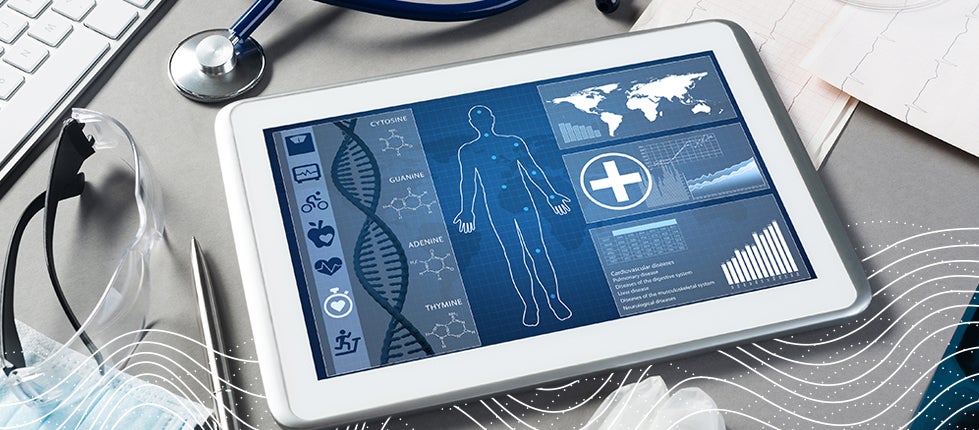
In today’s world, the human experience is becoming inherently more digital and connected. With consumer devices and applications managing a wide range of tasks and experiences for users on a daily basis, it’s clear that our medical devices cannot lag behind.
Beyond ensuring that innovative medical devices meet consumer expectations and aligns with their current reality, medical device manufacturers need to take a closer look at human machine interfaces (HMI) in order to transform the future of health and patient delivery. HMI, which gives humans the ability to operate as controllers for machines, plays an integral role as the medical technology industry transforms and creates and delivers innovations that are smarter, more connected to improve healthcare and patient lives.

Managing the healthcare system’s rising demands
Our healthcare system is under greater demand than ever. From the aftershocks of the COVID‑19 pandemic, to a growing aging population with chronic disease on the rise, to rising costs and ongoing staffing challenges, healthcare providers need to find new ways to effectively care for large and diverse patient populations, while also empowering individuals to manage their own care. Recent research studies project that between 170 million and 230 million Americans could be living with one or more chronic conditions by 2030, while the Centers for Disease Control (CDC) reports that chronic diseases are currently the leading drivers of the nation’s $4.1 trillion in annual health care costs.
The rise of connected health
Thankfully, the rise of connected health can address many of these issues. These devices — especially those with intuitive designs — already play a crucial role in our daily lives. Whether we’re calculating daily steps on wearable fitness trackers, FaceTiming with loved ones on an iPhone, or asking Alexa for a dinner recipe, it’s easy to take for granted the myriad ways in which technology seamlessly shapes our habits and makes our lives easier. When it comes to our health, we also have come to rely on products like continuous glucose monitoring systems, wearable vital sign monitors, and sleep support devices.
These products — whether consumer or medical devices — share one commonality: their intuitive design and HMI makes them easy or even automatic to operate, which makes them “stickier” with end users. This must be a guiding principle when designing medical devices. They should make our lives easier, healthier, and more efficient without adding more steps or complexity. To support consumer demand and market trends, healthcare companies must ensure that at the design phase, HMI, and the overall user experience is taken into consideration to ensure more resilient and innovative products. By anticipating the opportunities and challenges of a more connected, digital world and ensuring that devices slide seamlessly into the end user’s life, medical device manufacturers can gain a competitive edge while delivering an improved patient experience.
Designing for an aging population
When designing smart devices, you don’t often think of an elderly population as the target audience. Older users tend to struggle to interface with newer technologies, especially if the information is perceived as too technical, or complicated to follow, or presented in a smaller format that could be difficult to read. This actually makes effective HMI more crucial, because designing for the average customer — not just the most tech-savvy one — means that devices are more likely to be used correctly by the end user.
There is a huge opportunity to improve care for the elderly through more intuitive medical devices with a simple, intuitive HMI. For example, according to the Department of Health and Human Services, 55% of the elderly are non-compliant with their prescription drug orders. Some of the solutions already being deployed to improve medication compliance include mobile phone applications, reminder systems, and even patient empowerment chat bots.
Helping the elderly population to interface with medical equipment will help address care gaps, enable patient education, and improve healthcare quality.
Tackling chronic illnesses head-on
As I mentioned earlier, the rise of chronic illnesses — and its associated financial toll — is something we should all be concerned about. The CDC defines chronic diseases as “conditions that last one year or more and require ongoing medical attention or limit activities of daily living or both.” These can be attributed to both our aging population and key risk behaviors such as tobacco use, poor nutrition, physical inactivity, excessive alcohol use, to name a few. Moreover, some people who had COVID-19 are experiencing long-term effects and chronic illnesses.
These patients need easier, faster, and reliable access to quality care so that they can effectively manage their ongoing health conditions and mitigate adverse outcomes.
Innovative medical devices can also vastly improve quality of life. Consider a soft robotic wearable that a team of researchers from the Harvard John A. Paulson School of Engineering and Applied Sciences (SEAS) developed in order to assist upper arm and shoulder movement in people with ALS. Though the product is not yet available commercially, its intuitive HMI — which meant that study participants learned how to operate the device in less than 15 minutes — will allow it to integrate into a patient’s everyday life with ease.
Another example is Flex’s development of a voice-controlled autoinjector demonstrator to enhance the dose-delivery user experience. The device pairs with a smartphone app, which guides the user with step-by-step instructions. The autoinjector’s HMI design, which provides prompts when needed and allows voice activation to “start” and “stop” the injection directly, addresses users’ issues with pressing buttons on autoinjector devices. By focusing on elegant, user-friendly HMI solutions, we can provide more intuitive and user-friendly experiences for patients who require ongoing management of chronic conditions.
Alleviating staffing issues
Another challenge for the healthcare industry that we’ve seen in recent years is ongoing staffing challenges. We saw COVID-19 disrupt more than just global supply chains. In many cases, the pandemic interrupted the important education and training for those embarking on a career in the medical field. Many also reconsidered remaining in the medical field due to burnout from an extremely stressful and often traumatizing work environment.
As the healthcare industry addresses ongoing staffing challenges, they will need to employ both short and long-term strategies. For healthcare systems, these strategies might include recruitment, training, and retention initiatives, while medical device manufacturers might look at how to improve product design to make devices error-proof so that they can be easily operated by a newer, less experienced or part-time workforce. Moreover, improving HMI for telemedicine solutions can alleviate the demands on the system, allowing patients in underserved or remote areas to access quality care even when there are staffing shortages in their local healthcare system.
Better, together
The importance of HMI in medical device development cannot be overstated. As the world becomes more digital and connected, medical device manufacturers are responsible for ensuring that their products are innovative, efficient, and user-friendly. By focusing on the needs and experience of the full spectrum of end users and making HMI a priority in device design, we can improve patient care, enhance user experience, and ultimately save lives.



